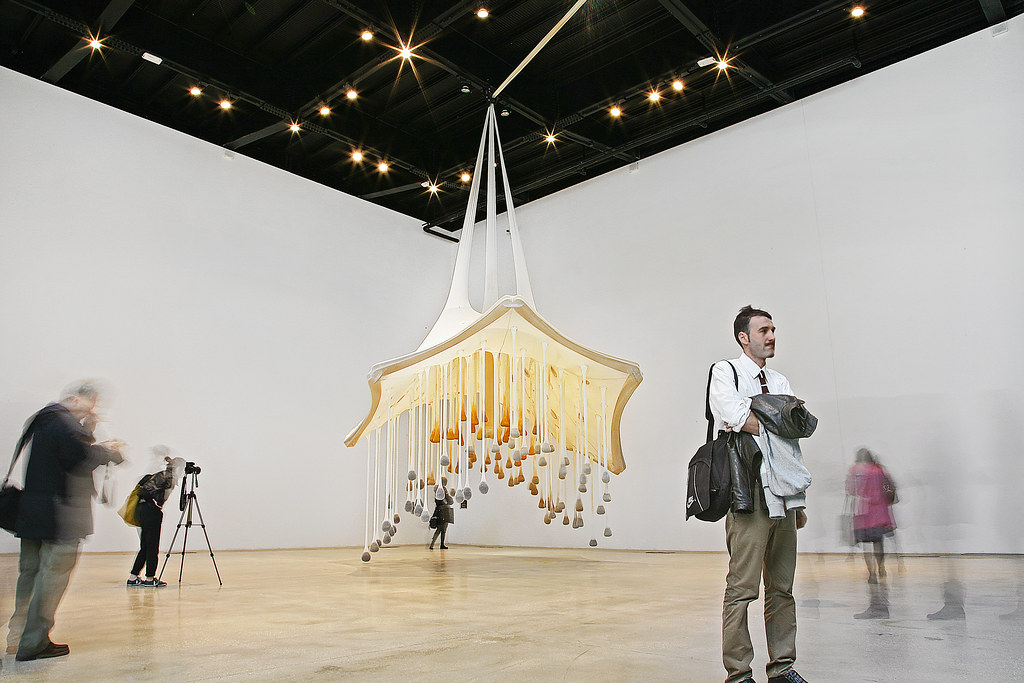While Nothing Happens by Ernesto Neto

In this installation piece suspended from the ceiling, lycra netting sacs contain spices, including pepper, cumin, cloves, ginger and curcuma, creating shapes similar almost to stalactites. These aromatic sacs combined with the soft material nature of the lycra invites the viewer to become participants and to touch the sacs. The spices are meant to conjure feelings of nostalgia and memories, creating a far more tangible experience than what might be gathered from simply looking at the abstract installation. As Neto says himself, in relation to his creative practice, “an art that unites, helping us interact with others, showing us the limits, not as barriers but as a place of sensations and of exchange and continuity.”
https://www.macroasilo.it/mostra/ernesto-neto-mentre-niente-accade-while-nothing-happens, https://www.artnexus.com/en/magazines/article-magazine artnexus/5d63427290cc21cf7c0a1de5/71/ernesto-neto
Applying to Soft Technologies
I love the idea of trying to appeal to new senses, beyond sight and sound. So, in soft technology, I would think about trying to apply something like smell, which Neto utilizes as a part of While Nothing Happens, to some form of actuation to communicate to the viewer that something has changed, or something is about to change. Could a soft technology blow spices at a person? Could the viewer select their spices? Could the machine select the viewer’s spices based on another selection? Would it do that in response to something seemly unrelated that a viewer does? How does spice travel through silicon? Does the sensed capacity be something that we (humans) sense at all?
Papers that explore soft robotic interaction with the user
- Alessandro Ubaldi, Mirko Gelsomini, Marzia Degiorgi, Giulia Leonardi, Simone Penati, Noëlie Ramuzat, Jacopo Silvestri, and Franca Garzotto. Puffy, a Friendly Inflatable Social Robot. In Extended Abstracts of the 2018 CHI Conference on Human Factors in Computing Systems, CHI EA ’18, 1. New York, NY, USA, April 2018. Association for Computing Machinery. doi:10.1145/3170427.3186595.
- Qi Wang, Zhenhua Wu, Jianyu Huang, Zhuolin Du, Yamei Yue, Dezhi Chen, Dong Li, Bin Su. Integration of sensing and shape-deforming capabilities for a bioinspired soft robot. In Composites Part B: Engineering, Volume 223, 15 October 2021. https://doi.org/10.1016/j.compositesb.2021.109116.
- Hongman Wang, Zhisen Zhu, He Jin, Rui Wei, Lei Bi, Wenling Zhang. Magnetic soft robots: Design, actuation, and function. In Journal of Alloys and Compounds, Volume 922, 20 November 2022. https://doi.org/10.1016/j.jallcom.2022.166219.
While I was unable to find any papers that tied smell and soft robotics, I enjoyed how much life was breathed into each of the robots in these papers. In class, we talked about how to create empathy for something intimate, and these papers showcased excellent examples of that. Particularly in the second paper with the anemone, by way of using two different kinds of actuation, is able to add a very organic feel of movement. I think that the closer a robot can achieve to organic motion, the more empathy and connection the viewer will feel towards the robot.